

Compact Muon Solenoid
LHC, CERN
| CMS-PAS-B2G-17-002 | ||
| Search for heavy resonances decaying into a vector boson and a Higgs boson in hadronic final states with 2016 data | ||
| CMS Collaboration | ||
| March 2017 | ||
| Abstract: A search for heavy resonances with a mass above 1 TeV, decaying to a vector boson and a Higgs boson is presented. The search considers hadronic decays of the vector boson, and Higgs boson decays to b quarks. The collimated pair of quarks are reconstructed as a single massive jet. The analysis is performed using a data sample collected in 2016 by the CMS experiment at the LHC in proton-proton collisions at a center-of-mass energy of 13 TeV, corresponding to an integrated luminosity of 35.9 fb$^{-1}$. The data is found to be consistent with the background expectation and used to place limits in the context of a theoretical model with a heavy vector triplet. In the benchmark scenario model B, a resonance with mass up to 3.4 TeV is excluded at 95% confidence level, and stringent limits are set on the parameters of the model. | ||
|
Links:
CDS record (PDF) ;
inSPIRE record ;
CADI line (restricted) ;
These preliminary results are superseded in this paper, EPJC 77 (2017) 636. The superseded preliminary plots can be found here. |
||
| Figures | Summary | Additional Figures | References | CMS Publications |
|---|
| Figures | |

png pdf |
Figure 1:
Distribution of the soft drop PUPPI mass for data, simulated background and signal. The distributions are normalized to the number of events observed in data. The dashed vertical lines represent the boundary values of the jet mass categories. |
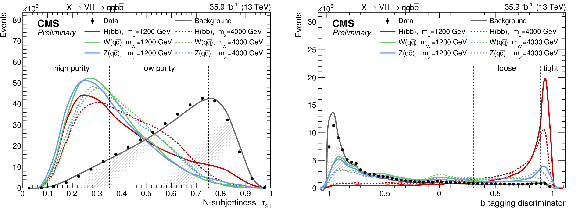
png pdf |
Figure 2:
Distribution of the N-subjettiness ${\tau _{21}}$ (left) and b tagging discriminator output (right) for data, simulated background and the signal. The distributions are normalized to the number of events observed in data. The dashed vertical lines represent the boundary values of the categories as described in the text. |
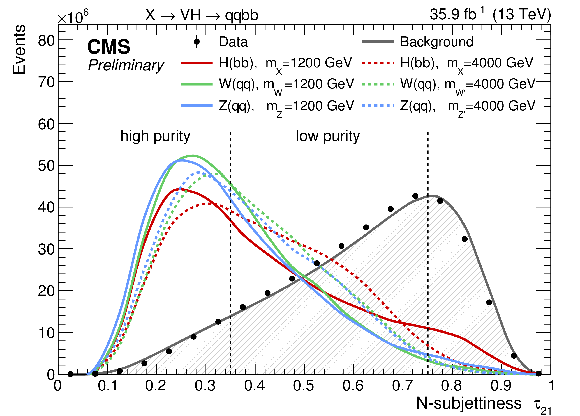
png pdf |
Figure 2-a:
Distribution of the N-subjettiness ${\tau _{21}}$ for data, simulated background and the signal. The distribution is normalized to the number of events observed in data. The dashed vertical lines represent the boundary values of the categories as described in the text. |

png pdf |
Figure 2-b:
Distribution of the b tagging discriminator output for data, simulated background and the signal. The distribution is normalized to the number of events observed in data. The dashed vertical lines represent the boundary values of the categories as described in the text. |

png pdf |
Figure 3:
Dijet invariant distribution ${m_{ { {\mathrm {V}} \mathrm{ H } } }}$ of the two leading jets in the ${\mathrm {W}}$ mass region: high purity (top) and low purity (bottom) categories, with tight (left) and loose (right) b tagging selections. The observed data are indicated by black markers, and the potential contribution of a resonance with ${m_{ {\mathrm {X}} }} =$ 2000 GeV produced in the context of the HVT model B with $ {g_\text {V}} =$ 3 is shown with a solid red line. The main and alternative functions shown represent the background-only fit. The bottom panels report the pulls in each bin, $(N^\text {data}-N^\text {bkg})/\sigma $, where $\sigma $ is the Poisson uncertainty in data. The error bars represent the normalized Poisson errors on the data and are shown also for bins with zero entries up to the highest ${m_{ { {\mathrm {V}} \mathrm{ H } } }}$ event. |

png pdf |
Figure 3-a:
Dijet invariant distribution ${m_{ { {\mathrm {V}} \mathrm{ H } } }}$ of the two leading jets in the ${\mathrm {W}}$ mass region: high purity category, with tight b tagging selections. The observed data are indicated by black markers, and the potential contribution of a resonance with ${m_{ {\mathrm {X}} }} =$ 2000 GeV produced in the context of the HVT model B with $ {g_\text {V}} =$ 3 is shown with a solid red line. The main and alternative functions shown represent the background-only fit. The bottom panels report the pulls in each bin, $(N^\text {data}-N^\text {bkg})/\sigma $, where $\sigma $ is the Poisson uncertainty in data. The error bars represent the normalized Poisson errors on the data and are shown also for bins with zero entries up to the highest ${m_{ { {\mathrm {V}} \mathrm{ H } } }}$ event. |
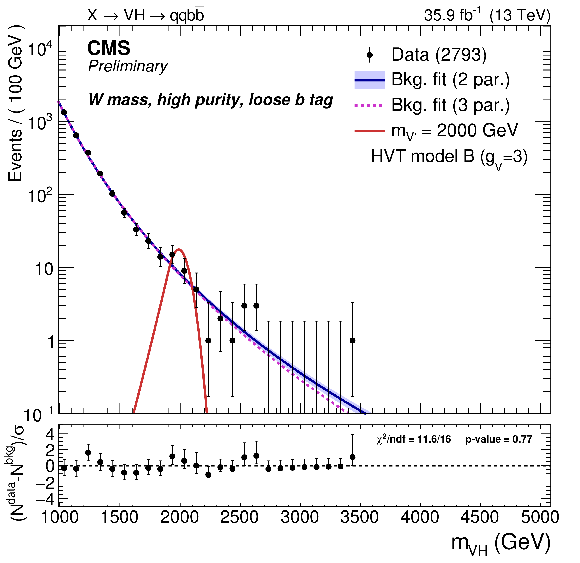
png pdf |
Figure 3-b:
Dijet invariant distribution ${m_{ { {\mathrm {V}} \mathrm{ H } } }}$ of the two leading jets in the ${\mathrm {W}}$ mass region: high purity category, with loose b tagging selection. The observed data are indicated by black markers, and the potential contribution of a resonance with ${m_{ {\mathrm {X}} }} =$ 2000 GeV produced in the context of the HVT model B with $ {g_\text {V}} =$ 3 is shown with a solid red line. The main and alternative functions shown represent the background-only fit. The bottom panels report the pulls in each bin, $(N^\text {data}-N^\text {bkg})/\sigma $, where $\sigma $ is the Poisson uncertainty in data. The error bars represent the normalized Poisson errors on the data and are shown also for bins with zero entries up to the highest ${m_{ { {\mathrm {V}} \mathrm{ H } } }}$ event. |
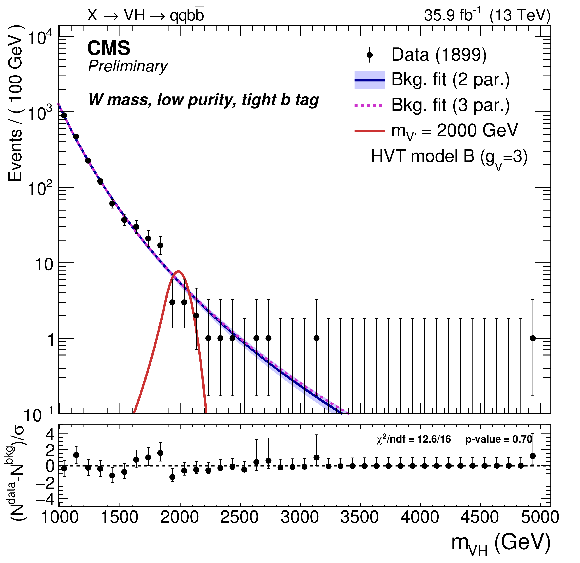
png pdf |
Figure 3-c:
Dijet invariant distribution ${m_{ { {\mathrm {V}} \mathrm{ H } } }}$ of the two leading jets in the ${\mathrm {W}}$ mass region: low purity category, with tight b tagging selection. The observed data are indicated by black markers, and the potential contribution of a resonance with ${m_{ {\mathrm {X}} }} =$ 2000 GeV produced in the context of the HVT model B with $ {g_\text {V}} =$ 3 is shown with a solid red line. The main and alternative functions shown represent the background-only fit. The bottom panels report the pulls in each bin, $(N^\text {data}-N^\text {bkg})/\sigma $, where $\sigma $ is the Poisson uncertainty in data. The error bars represent the normalized Poisson errors on the data and are shown also for bins with zero entries up to the highest ${m_{ { {\mathrm {V}} \mathrm{ H } } }}$ event. |
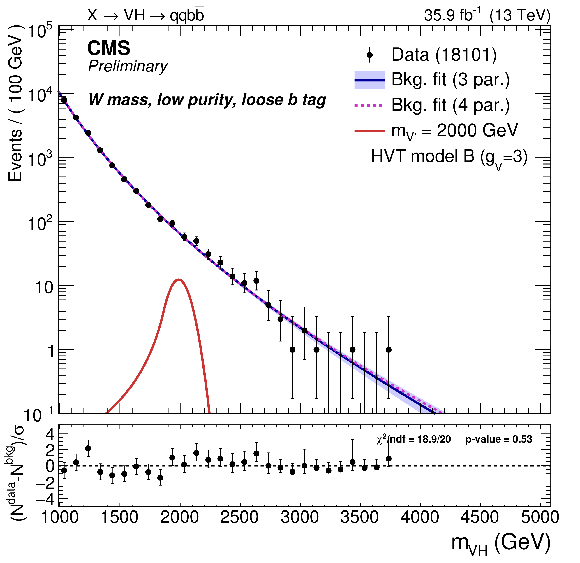
png pdf |
Figure 3-d:
Dijet invariant distribution ${m_{ { {\mathrm {V}} \mathrm{ H } } }}$ of the two leading jets in the ${\mathrm {W}}$ mass region: low purity category, with loose b tagging selections. The observed data are indicated by black markers, and the potential contribution of a resonance with ${m_{ {\mathrm {X}} }} =$ 2000 GeV produced in the context of the HVT model B with $ {g_\text {V}} =$ 3 is shown with a solid red line. The main and alternative functions shown represent the background-only fit. The bottom panels report the pulls in each bin, $(N^\text {data}-N^\text {bkg})/\sigma $, where $\sigma $ is the Poisson uncertainty in data. The error bars represent the normalized Poisson errors on the data and are shown also for bins with zero entries up to the highest ${m_{ { {\mathrm {V}} \mathrm{ H } } }}$ event. |

png pdf |
Figure 4:
Dijet invariant distribution ${m_{ { {\mathrm {V}} \mathrm{ H } } }}$ of the two leading jets in the Z mass region: high purity (top) and low purity (bottom) categories, with tight (left) and loose (right) b tagging selections. The observed data are indicated by black markers, and the potential contribution of a resonance with ${m_{ {\mathrm {X}} }} = $ 2000 GeV produced in the context of the HVT model B with $ {g_\text {V}} =$ 3 is shown with a solid red line. The main and alternative functions shown represent the background-only fit. The bottom panels report the pulls in each bin, $(N^\text {data}-N^\text {bkg})/\sigma $, where $\sigma $ is the Poisson uncertainty in data. The error bars represent the normalized Poisson errors on the data and are shown also for bins with zero entries up to the highest ${m_{ { {\mathrm {V}} \mathrm{ H } } }}$ event. |
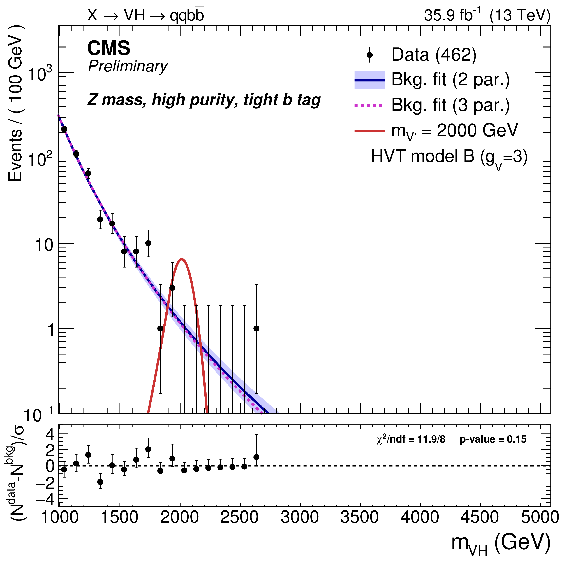
png pdf |
Figure 4-a:
Dijet invariant distribution ${m_{ { {\mathrm {V}} \mathrm{ H } } }}$ of the two leading jets in the Z mass region: high purity category, with tight b tagging selection. The observed data are indicated by black markers, and the potential contribution of a resonance with ${m_{ {\mathrm {X}} }} = $ 2000 GeV produced in the context of the HVT model B with $ {g_\text {V}} =$ 3 is shown with a solid red line. The main and alternative functions shown represent the background-only fit. The bottom panels report the pulls in each bin, $(N^\text {data}-N^\text {bkg})/\sigma $, where $\sigma $ is the Poisson uncertainty in data. The error bars represent the normalized Poisson errors on the data and are shown also for bins with zero entries up to the highest ${m_{ { {\mathrm {V}} \mathrm{ H } } }}$ event. |
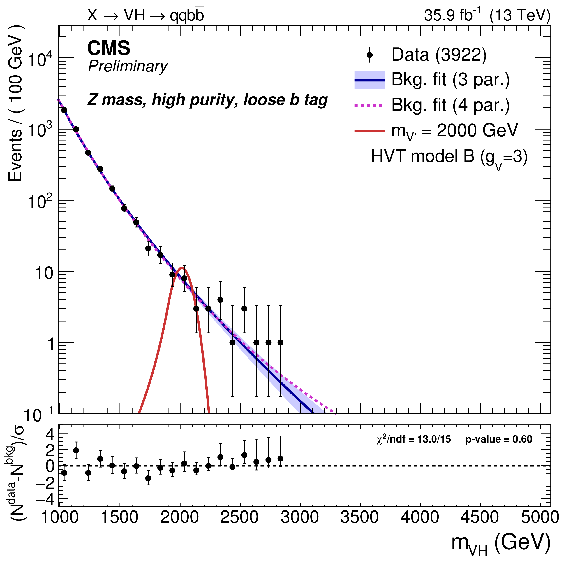
png pdf |
Figure 4-b:
Dijet invariant distribution ${m_{ { {\mathrm {V}} \mathrm{ H } } }}$ of the two leading jets in the Z mass region: high purity category, with loose b tagging selection. The observed data are indicated by black markers, and the potential contribution of a resonance with ${m_{ {\mathrm {X}} }} = $ 2000 GeV produced in the context of the HVT model B with $ {g_\text {V}} =$ 3 is shown with a solid red line. The main and alternative functions shown represent the background-only fit. The bottom panels report the pulls in each bin, $(N^\text {data}-N^\text {bkg})/\sigma $, where $\sigma $ is the Poisson uncertainty in data. The error bars represent the normalized Poisson errors on the data and are shown also for bins with zero entries up to the highest ${m_{ { {\mathrm {V}} \mathrm{ H } } }}$ event. |
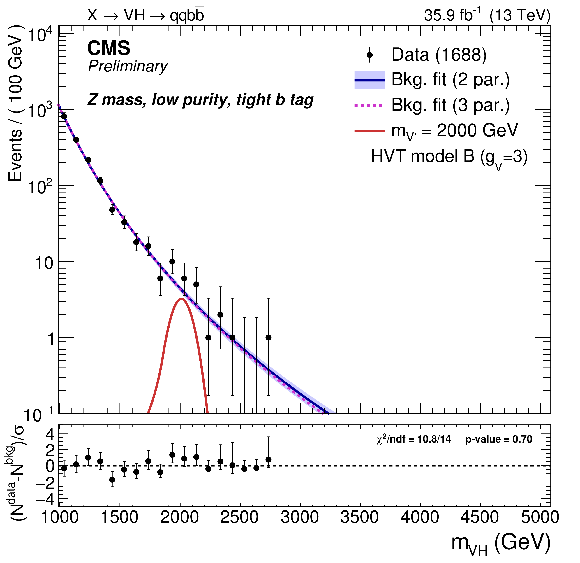
png pdf |
Figure 4-c:
Dijet invariant distribution ${m_{ { {\mathrm {V}} \mathrm{ H } } }}$ of the two leading jets in the Z mass region: low purity category, with tight b tagging selection. The observed data are indicated by black markers, and the potential contribution of a resonance with ${m_{ {\mathrm {X}} }} = $ 2000 GeV produced in the context of the HVT model B with $ {g_\text {V}} =$ 3 is shown with a solid red line. The main and alternative functions shown represent the background-only fit. The bottom panels report the pulls in each bin, $(N^\text {data}-N^\text {bkg})/\sigma $, where $\sigma $ is the Poisson uncertainty in data. The error bars represent the normalized Poisson errors on the data and are shown also for bins with zero entries up to the highest ${m_{ { {\mathrm {V}} \mathrm{ H } } }}$ event. |
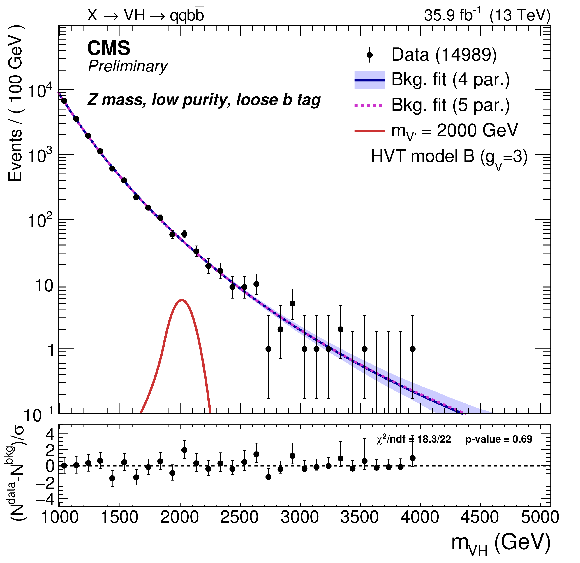
png pdf |
Figure 4-d:
Dijet invariant distribution ${m_{ { {\mathrm {V}} \mathrm{ H } } }}$ of the two leading jets in the Z mass region: low purity category, with loose b tagging selection. The observed data are indicated by black markers, and the potential contribution of a resonance with ${m_{ {\mathrm {X}} }} = $ 2000 GeV produced in the context of the HVT model B with $ {g_\text {V}} =$ 3 is shown with a solid red line. The main and alternative functions shown represent the background-only fit. The bottom panels report the pulls in each bin, $(N^\text {data}-N^\text {bkg})/\sigma $, where $\sigma $ is the Poisson uncertainty in data. The error bars represent the normalized Poisson errors on the data and are shown also for bins with zero entries up to the highest ${m_{ { {\mathrm {V}} \mathrm{ H } } }}$ event. |
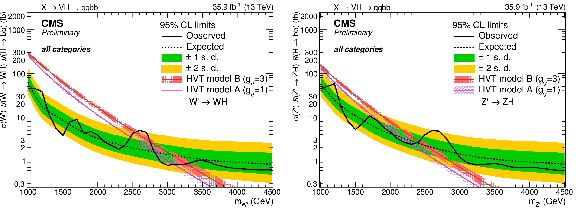
png pdf |
Figure 5:
Observed and expected 95% CL upper limits on $\sigma ( {\mathrm {W}} ') {\mathcal {B}}( {\mathrm {W}} '\to {\mathrm {W}} {\mathrm {H}}) {\mathcal {B}}( {\mathrm{ H } \to {\mathrm{ b \bar{b} } } })$ (left) and $\sigma (\mathrm{ Z }') {\mathcal {B}}(\mathrm{ Z }' \to {\mathrm{ Z } } {\mathrm {H}}) {\mathcal {B}}( {\mathrm{ H } \to {\mathrm{ b \bar{b} } } })$ (right) as a function of the resonance mass for a single narrow spin-1 resonance, including all statistical and systematic uncertainties. The inner green and outer yellow bands represent the ${\pm }$1 and ${\pm }$2 standard deviation uncertainties on the expected limit. The red and purple solid curves correspond to the cross sections predicted by the HVT modelB ($ {g_\text {V}} =$ 3) and modelA ($ {g_\text {V}} =$ 1), respectively. |
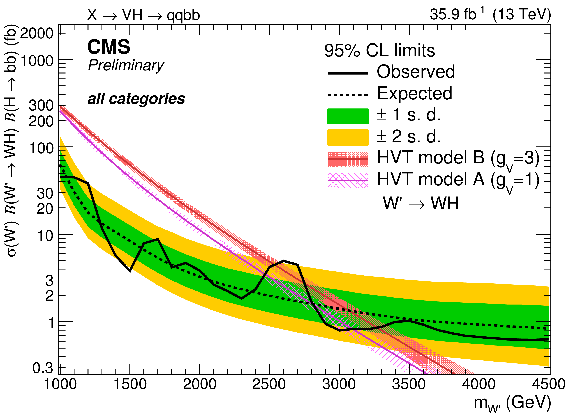
png pdf |
Figure 5-a:
Observed and expected 95% CL upper limits on $\sigma ( {\mathrm {W}} ') {\mathcal {B}}( {\mathrm {W}} '\to {\mathrm {W}} {\mathrm {H}}) {\mathcal {B}}( {\mathrm{ H } \to {\mathrm{ b \bar{b} } } })$ as a function of the resonance mass for a single narrow spin-1 resonance, including all statistical and systematic uncertainties. The inner green and outer yellow bands represent the ${\pm }$1 and ${\pm }$2 standard deviation uncertainties on the expected limit. The red and purple solid curves correspond to the cross sections predicted by the HVT modelB ($ {g_\text {V}} =$ 3) and modelA ($ {g_\text {V}} =$ 1), respectively. |
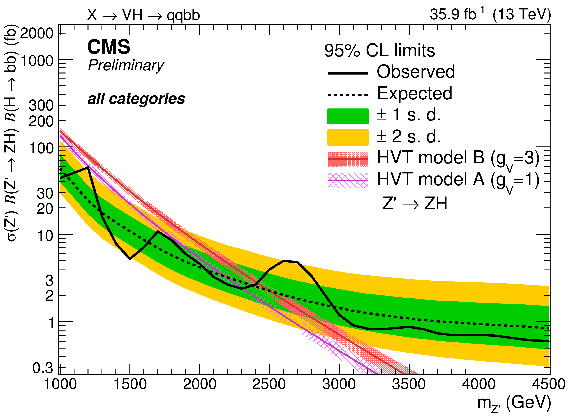
png pdf |
Figure 5-b:
Observed and expected 95% CL upper limits on $\sigma (\mathrm{ Z }') {\mathcal {B}}(\mathrm{ Z }' \to {\mathrm{ Z } } {\mathrm {H}}) {\mathcal {B}}( {\mathrm{ H } \to {\mathrm{ b \bar{b} } } })$ as a function of the resonance mass for a single narrow spin-1 resonance, including all statistical and systematic uncertainties. The inner green and outer yellow bands represent the ${\pm }$1 and ${\pm }$2 standard deviation uncertainties on the expected limit. The red and purple solid curves correspond to the cross sections predicted by the HVT modelB ($ {g_\text {V}} =$ 3) and modelA ($ {g_\text {V}} =$ 1), respectively. |
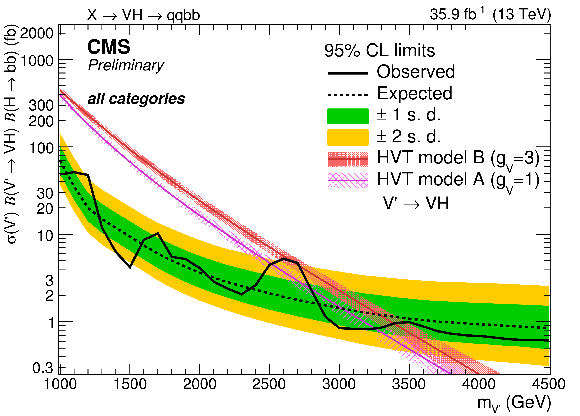
png pdf |
Figure 6:
Observed and expected 95% CL upper limit with the ${\pm }$1 and ${\pm }$2 standard deviation uncertainty bands on $\sigma ( {\mathrm {X}}) {\mathcal {B}}( {\mathrm {X}} \to { {\mathrm {V}} \mathrm{ H } }) {\mathcal {B}}( {\mathrm{ H } \to {\mathrm{ b \bar{b} } } })$ in the combined heavy vector triplet hypothesis, for the combination of all the considered channels. The red and purple solid curves correspond to the cross sections predicted by the HVT modelB ($ {g_\text {V}} =$ 3) and modelA ($ {g_\text {V}} =$ 1), respectively. |
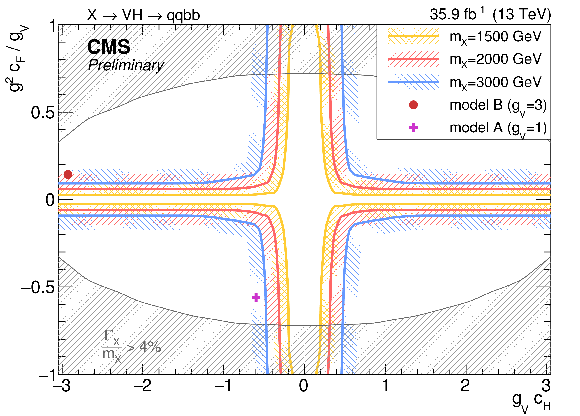
png pdf |
Figure 7:
Observed exclusion in the HVT parameter plane $ [ {g_\text {V}} {c_\text {H}} , \ g^2 {c_\text {F}} / {g_\text {V}}] $ for three different resonance masses (1.5, 2.0, and 3.0 TeV). The parameter $ {g_\text {V}} $ represents the coupling strength of the new interaction, $ {c_\text {H}} $ the coupling between the HVT bosons and the Higgs boson and longitudinally polarized SM vector bosons, and $ {c_\text {F}} $ the coupling between the heavy vector bosons and the SM fermions. The benchmark scenario corresponding to HVT modelA ($ {g_\text {V}} =$ 1) and modelB ($ {g_\text {V}} =$ 3) are represented by a purple cross and a red point. The gray shaded area corresponds to the region where the resonance natural width is predicted to be larger than the typical experimental resolution (4%), and thus the narrow-width approximation is not fulfilled. |
| Summary |
| A search for a heavy resonance with mass above 1 TeV and decaying into a vector boson and a Higgs boson, has been presented. The final states explored include the hadronic decay modes of the vector boson, and the decay of the Higgs boson to a $\text{b}\bar{\text{b}}$ pair. The data sample was collected by the CMS experiment at $\sqrt{s}=$ 13 TeV during 2016, and corresponds to an integrated luminosity of 35.9 fb$^{-1}$. Depending on the resonance mass, upper limits in the range 0.8-50 fb are set on the product of the cross section for a triplet of narrow spin-1 resonance and the branching fractions for the decay of the resonance into a Higgs and a vector boson, and for the decay of the Higgs boson into a pair of b quarks. The excluded resonance mass range is extended from 2.0 TeV to up to $3.4$ TeV within the heavy vector triplet model in the benchmark scenario B ($g_\text{V}=$ 3) with respect to the previous CMS searches, resulting in a significant reduction in the allowed parameter space for the large number of models generalized within the heavy vector triplet framework. |
| Additional Figures | |

png pdf |
Additional Figure 1:
Signal efficiency for a W' (left ) and Z' signal (right ). The colored lines represent the selection efficiency for each single category. The solid black line represents the efficiency of the 8 categories combined. The efficiencies are determined with respect to the number of generated events. |
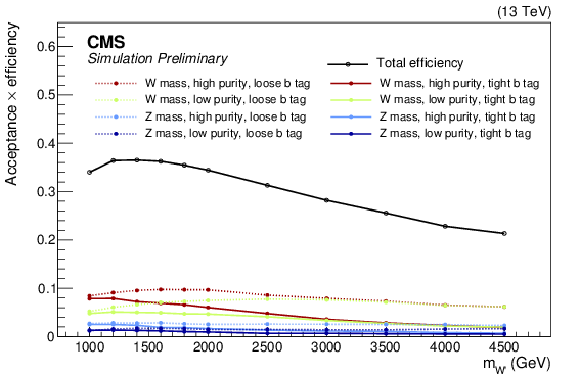
png pdf |
Additional Figure 1-a:
Signal efficiency for a W' (left ) and Z' signal (right ). The colored lines represent the selection efficiency for each single category. The solid black line represents the efficiency of the 8 categories combined. The efficiencies are determined with respect to the number of generated events. |
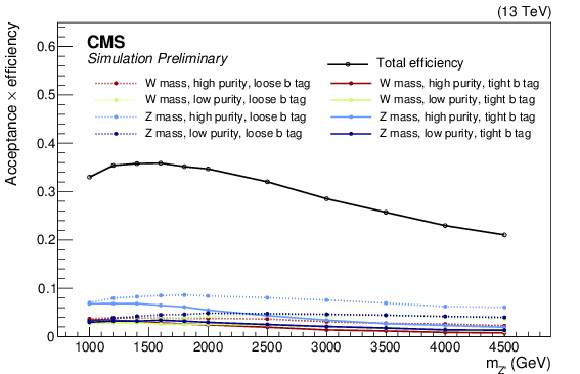
png pdf |
Additional Figure 1-b:
Signal efficiency for a W' (left ) and Z' signal (right ). The colored lines represent the selection efficiency for each single category. The solid black line represents the efficiency of the 8 categories combined. The efficiencies are determined with respect to the number of generated events. |
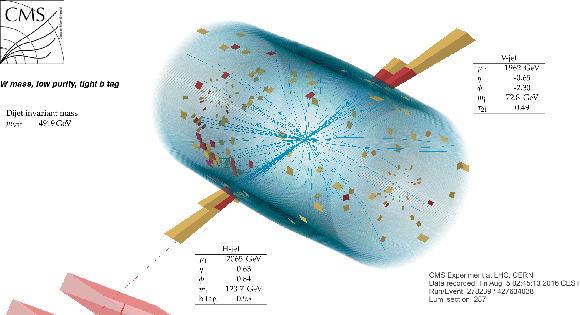
png pdf |
Additional Figure 2:
Event display of the highest dijet mass event (4919 GeV) observed in data (3D view). The muon contained in the H-jet candidate, represented with a red track, is not isolated and has a transverse momentum of 20 GeV. The third jet, ordered in $ {p_{\mathrm {T}}} $, has a transverse momentum of 136 GeV. |
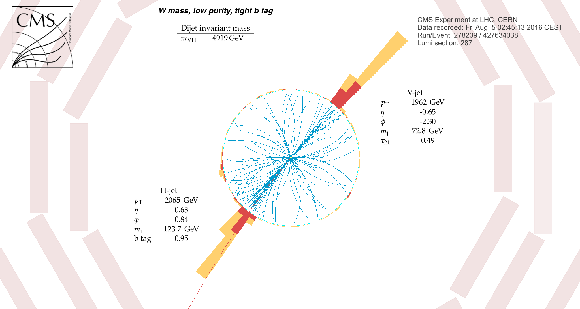
png pdf |
Additional Figure 3:
Event display of the highest dijet mass event (4919 GeV) observed in data (projection on the transverse plane). The muon contained in the H-jet candidate, represented with a red track, is not isolated and has a transverse momentum of 20 GeV. The third jet, ordered in $ {p_{\mathrm {T}}} $, has a transverse momentum of 136 GeV. |
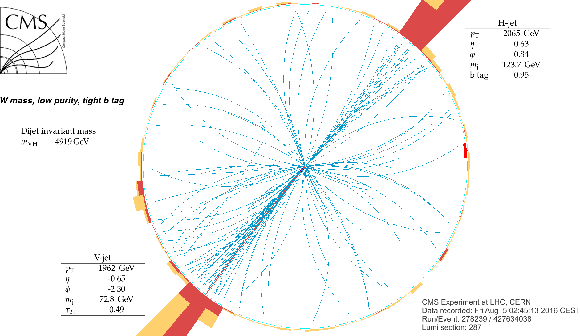
png pdf |
Additional Figure 4:
Event display of the highest dijet mass event (4919 GeV) observed in data (close view of the projection on the transverse plane). The blue points represent the secondary vertices reconstructed within the H-jet candidate. Yellow points represent the primary vertices. |

png pdf |
Additional Figure 5:
Event display of the highest dijet mass event (4919 GeV) observed in data (projection on the longitudinal plane). |
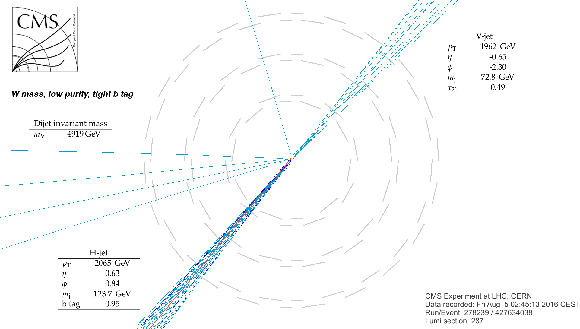
png pdf |
Additional Figure 6:
Close view of the projection on the transverse plane of the highest dijet mass event (4919 GeV) observed in data. The gray lines represent the CMS pixel barrel detector. The blue points show the secondary vertices reconstructed within the H-jet candidate. Yellow points represent the primary vertices. Tracks with $ {p_{\mathrm {T}}} < $ 5 GeV are now drawn. |
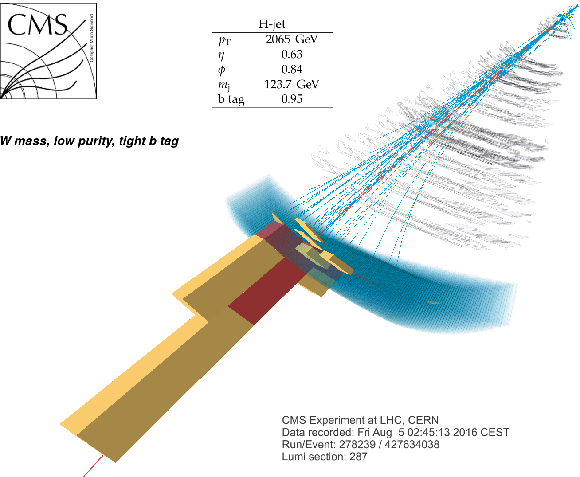
png pdf |
Additional Figure 7:
H-jet candidate of the highest dijet mass event (4919 GeV) observed in data. The muon contained in the H-jet candidate, represented with a red track, is not isolated and has a transverse momentum of 20 GeV. The blue points show the secondary vertices reconstructed within the H-jet candidate. Yellow points represent the primary vertices. |
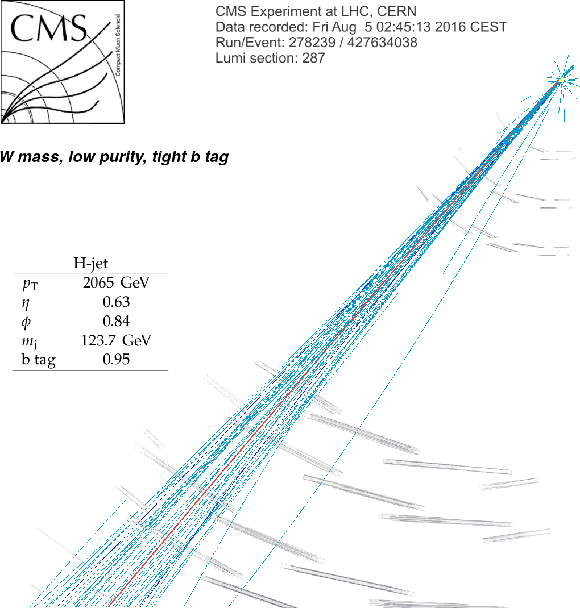
png pdf |
Additional Figure 8:
H-jet candidate in the tracker and pixel region of the highest dijet mass event (4919 GeV) observed in data. The muon contained in the H-jet candidate, represented with a red track, is not isolated and has a transverse momentum of 20 GeV. The blue points show the secondary vertices reconstructed within the H-jet candidate. Yellow points represent the primary vertices. |
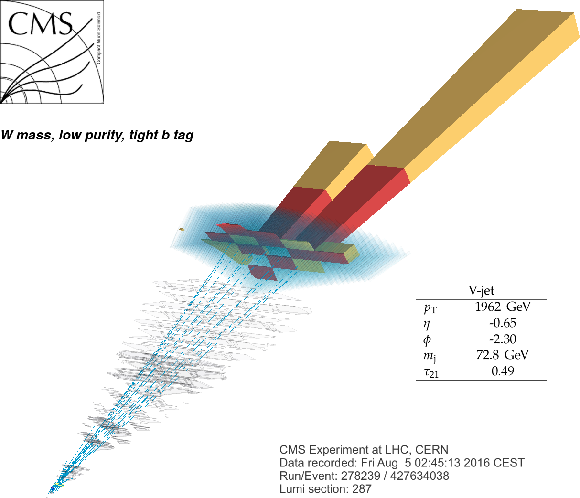
png pdf |
Additional Figure 9:
V-jet candidate of the highest dijet mass event (4919 GeV) observed in data. |
| References | ||||
| 1 | ATLAS Collaboration | Observation of a new particle in the search for the Standard Model Higgs boson with the ATLAS detector at the LHC | PLB 716 (2012) 1 | 1207.7214 |
| 2 | CMS Collaboration | Observation of a new boson at a mass of 125 GeV with the CMS experiment at the LHC | PLB 716 (2012) 30 | CMS-HIG-12-028 1207.7235 |
| 3 | CMS Collaboration | Observation of a new boson with mass near 125 GeV in pp collisions at $ \sqrt{s} $ = 7 and 8 TeV | JHEP 06 (2013) 081 | CMS-HIG-12-036 1303.4571 |
| 4 | ATLAS Collaboration | Measurement of the Higgs boson mass from the $ H\rightarrow{}\gamma{}\gamma{} $ and $ H\rightarrow{}Z{Z}^{*}\rightarrow{}4\ell{} $ channels in $ pp $ collisions at center-of-mass energies of 7 and 8~TeV with the ATLAS detector | PRD 90 (2014) 052004 | 1406.3827 |
| 5 | CMS Collaboration | Precise determination of the mass of the Higgs boson and tests of compatibility of its couplings with the standard model predictions using proton collisions at 7 and 8 TeV | EPJC 75 (2015) 212 | CMS-HIG-14-009 1412.8662 |
| 6 | CMS Collaboration | Evidence for the direct decay of the 125 GeV Higgs boson to fermions | Nat. Phys. 10 (2014) 557 | CMS-HIG-13-033 1401.6527 |
| 7 | ATLAS and CMS Collaborations | Combined Measurement of the Higgs Boson Mass in $ pp $ Collisions at $ \sqrt{s}=$ 7 and 8 TeV with the ATLAS and CMS Experiments | PRL 114 (2015) 191803 | 1503.07589 |
| 8 | V. D. Barger, W.-Y. Keung, and E. Ma | A gauge model with light $ W $ and $ Z $ bosons | PRD 22 (1980) 727 | |
| 9 | E. Salvioni, G. Villadoro, and F. Zwirner | Minimal Z' models: present bounds and early LHC reach | JHEP 09 (2009) 068 | 0909.1320 |
| 10 | C. Grojean, E. Salvioni, and R. Torre | A weakly constrained W$ ' $ at the early LHC | JHEP 07 (2011) 002 | 1103.2761 |
| 11 | R. Contino, D. Pappadopulo, D. Marzocca, and R. Rattazzi | On the effect of resonances in composite Higgs phenomenology | JHEP 10 (2011) 081 | 1109.1570 |
| 12 | D. Marzocca, M. Serone, and J. Shu | General composite Higgs models | JHEP 08 (2012) 13 | 1205.0770 |
| 13 | B. Bellazzini, C. Csaki, and J. Serra | Composite Higgses | EPJC 74 (2014) 2766 | 1401.2457 |
| 14 | T. Han, H. E. Logan, B. McElrath, and L.-T. Wang | Phenomenology of the little Higgs model | PRD 67 (2003) 095004 | hep-ph/0301040 |
| 15 | M. Schmaltz and D. Tucker-Smith | Little Higgs Theories | Ann. Rev. Nucl. Part. Sci. 55 (2005) 229 | |
| 16 | M. Perelstein | Little Higgs models and their phenomenology | Prog. Part. Nucl. Phys. 58 (2007) 247 | hep-ph/0512128 |
| 17 | D. Pappadopulo, A. Thamm, R. Torre, and A. Wulzer | Heavy vector triplets: bridging theory and data | JHEP 09 (2014) 60 | 1402.4431 |
| 18 | CMS Collaboration | Search for a pseudoscalar boson decaying into a Z boson and the 125 GeV Higgs boson in $ \ell^+\ell^- b\overline{b} $ final states | PLB 748 (2015) 221 | CMS-HIG-14-011 1504.04710 |
| 19 | CMS Collaboration | Search for a massive resonance decaying into a Higgs boson and a W or Z boson in hadronic final states in proton-proton collisions at $ \sqrt{s}=$ 8 TeV | JHEP 02 (2016) 145 | CMS-EXO-14-009 1506.01443 |
| 20 | CMS Collaboration | Search for Narrow High-Mass Resonances in Proton-Proton Collisions at $ \sqrt{s} $ = 8 TeV Decaying to a Z and a Higgs Boson | PLB 748 (2015) 255 | CMS-EXO-13-007 1502.04994 |
| 21 | CMS Collaboration | Search for massive resonances decaying into WW, WZ, ZZ, qW and qZ in the dijet final state at $ \sqrt{s} = $ 13 TeV | ||
| 22 | CMS Collaboration | Combination of diboson resonance searches at 8 and 13 TeV | CMS-PAS-B2G-16-007 | CMS-PAS-B2G-16-007 |
| 23 | CMS Collaboration | Search for new resonances decaying to $ \mathrm{WW}/\mathrm{WZ} \to \ell\nu \mathrm{qq} $ | CMS-PAS-B2G-16-020 | CMS-PAS-B2G-16-020 |
| 24 | CMS Collaboration | Search for heavy resonances decaying into a $ \mathrm{Z} $ boson and a $ \mathrm{W} $ boson in the $ \ell^+\ell^-\mathrm{q}\bar{\mathrm{q}} $ final state | CMS-PAS-B2G-16-022 | CMS-PAS-B2G-16-022 |
| 25 | ATLAS Collaboration | Search for resonances with boson-tagged jets in 15.5 fb$ ^{-1} $ of $ pp $ collisions at $ \sqrt{s} = $ 13 TeV collected with the ATLAS detector | ||
| 26 | ATLAS Collaboration | Search for diboson resonance production in the $ \ell\nu qq $ final state using $ pp $ collisions at $ \sqrt{s}=$ 13 TeV with the ATLAS detector at the LHC | ||
| 27 | ATLAS Collaboration | Searches for heavy ZZ and ZW resonances in the llqq and vvqq final states in pp collisions at $ \sqrt{s} = $ 13 TeV with the ATLAS detector | ||
| 28 | CMS Collaboration | Search for heavy resonances decaying into a vector boson and a Higgs boson in final states with charged leptons, neutrinos, and b quarks | PLB 768 (2017) | CMS-B2G-16-003 1610.08066 |
| 29 | ATLAS Collaboration | Search for new resonances decaying to a $ W $ or $ Z $ boson and a Higgs boson in the $ \ell^+ \ell^- b\bar b $, $ \ell \nu b\bar b $, and $ \nu\bar{\nu} b\bar b $ channels with $ pp $ collisions at $ \sqrt s = 13 $ TeV with the ATLAS detector | PLB 765 (2016) | 1607.05621 |
| 30 | ATLAS Collaboration | A Search for Resonances Decaying to a $ W $ or $ Z $ Boson and a Higgs Boson in the $ q\bar{q}^{(\prime)}b\bar{b} $ Final State | ATLAS Conference Note ATLAS-CONF-2016-083, CERN, Geneva | |
| 31 | J. Alwall et al. | The automated computation of tree-level and next-to-leading order differential cross sections, and their matching to parton shower simulations | JHEP 07 (2014) 079 | 1405.0301 |
| 32 | P. Nason | A new method for combining NLO QCD with shower Monte Carlo algorithms | JHEP 11 (2004) 040 | hep-ph/0409146 |
| 33 | S. Frixione, P. Nason, and C. Oleari | Matching NLO QCD computations with Parton Shower simulations: the POWHEG method | JHEP 11 (2007) 070 | 0709.2092 |
| 34 | S. Alioli, P. Nason, C. Oleari, and E. Re | A general framework for implementing NLO calculations in shower Monte Carlo programs: the POWHEG BOX | JHEP 06 (2010) 043 | 1002.2581 |
| 35 | M. Czakon and A. Mitov | Top++: A program for the calculation of the top-pair cross-section at hadron colliders | CPC 185 (2014) 2930 | 1112.5675 |
| 36 | T. Sjostrand, S. Mrenna, and P. Skands | A brief introduction to PYTHIA 8.1 | CPC 178 (2008) 852 | 0710.3820 |
| 37 | T. Sjostrand, S. Mrenna, and P. Skands | PYTHIA 6.4 physics and manual | JHEP 05 (2006) 026 | hep-ph/0603175 |
| 38 | P. Skands, S. Carrazza, and J. Rojo | Tuning PYTHIA 8.1: the Monash 2013 Tune | EPJC 74 (2014) 3024 | 1404.5630 |
| 39 | CMS Collaboration | Event generator tunes obtained from underlying event and multiparton scattering measurements | EPJC 76 (2016) 155 | CMS-GEN-14-001 1512.00815 |
| 40 | CMS Collaboration | Investigations of the impact of the parton shower tuning in Pythia 8 in the modelling of $ \mathrm{t\overline{t}} $ at $ \sqrt{s}=$ 8 and 13 TeV | CMS-PAS-TOP-16-021 | CMS-PAS-TOP-16-021 |
| 41 | NNPDF Collaboration | Parton distributions for the LHC Run II | JHEP 04 (2015) 040 | 1410.8849 |
| 42 | GEANT4 Collaboration | GEANT4---a simulation toolkit | NIMA 506 (2003) 250 | |
| 43 | CMS Collaboration | Description and performance of track and primary-vertex reconstruction with the CMS tracker | JINST 9 (2014) P10009 | CMS-TRK-11-001 1405.6569 |
| 44 | CMS Collaboration | The CMS experiment at the CERN LHC | JINST 3 (2008) S08004 | CMS-00-001 |
| 45 | CMS Collaboration | The CMS trigger system | JINST 12 (2017) P01020 | CMS-TRG-12-001 1609.02366 |
| 46 | CMS Collaboration | Particle-flow event reconstruction in CMS and performance for jets, taus, and $ E_{\mathrm{T}}^{\text{miss}} $ | CDS | |
| 47 | CMS Collaboration | Commissioning of the particle-flow event with the first LHC collisions recorded in the CMS detector | CDS | |
| 48 | M. Cacciari, G. P. Salam, and G. Soyez | The anti-$ k_\text{t} $ jet clustering algorithm | JHEP 04 (2008) 063 | 0802.1189 |
| 49 | CMS Collaboration | Pileup Removal Algorithms | CMS-PAS-JME-14-001 | CMS-PAS-JME-14-001 |
| 50 | M. Cacciari, G. P. Salam, and G. Soyez | FastJet user manual | EPJC 72 (2012) 1896 | 1111.6097 |
| 51 | M. Cacciari, G. P. Salam, and G. Soyez | The catchment area of jets | JHEP 04 (2008) 005 | 0802.1188 |
| 52 | CMS Collaboration | Jet energy scale and resolution in the CMS experiment in pp collisions at 8 TeV | JINST 12 (2017), no. 02, P02014 | CMS-JME-13-004 1607.03663 |
| 53 | D. Bertolini, P. Harris, M. Low, and N. Tran | Pileup per particle identification | Journal of High Energy Physics 2014 (2014) 59 | |
| 54 | M. Dasgupta, A. Fregoso, S. Marzani, and G. P. Salam | Towards an understanding of jet substructure | JHEP 09 (2013) 029 | 1307.0007 |
| 55 | A. J. Larkoski, S. Marzani, G. Soyez, and J. Thaler | Soft drop | JHEP 05 (2014) 146 | 1402.2657 |
| 56 | CMS Collaboration | Identification techniques for highly boosted W bosons that decay into hadrons | JHEP 12 (2014) 017 | CMS-JME-13-006 1410.4227 |
| 57 | J. Thaler and K. Van Tilburg | Identifying Boosted Objects with N-subjettiness | JHEP 03 (2011) 015 | 1011.2268 |
| 58 | CMS Collaboration | Identification of double-b quark jets in boosted event topologies | CMS-PAS-BTV-15-002 | CMS-PAS-BTV-15-002 |
| 59 | D. Krohn, J. Thaler, and L.-T. Wang | Jet Trimming | JHEP 02 (2010) 084 | 0912.1342 |
| 60 | M. Bahr et al. | Herwig++ physics and manual | EPJC 58 (2008) 639 | 0803.0883 |
| 61 | CMS Collaboration | CMS Luminosity Measurement for the 2016 Data Taking Period | ||
| 62 | J. Butterworth et al. | PDF4LHC recommendations for LHC Run II | JPG 43 (2016) 23001 | 1510.03865 |
| 63 | T. Junk | Confidence level computation for combining searches with small statistics | NIMA 434 (1999) 435 | hep-ex/9902006 |
| 64 | A. L. Read | Presentation of search results: the $ CL_s $ technique | JPG 28 (2002) 2693 | |
| 65 | CMS and ATLAS Collaborations | Procedure for the LHC Higgs boson search combination in Summer 2011 | CMS-NOTE-2011-005 | |
| 66 | G. Cowan, K. Cranmer, E. Gross, and O. Vitells | Asymptotic formulae for likelihood-based tests of new physics | EPJC 71 (2011) 1554 | 1007.1727 |

|
Compact Muon Solenoid LHC, CERN |

|

|

|

|

|

|